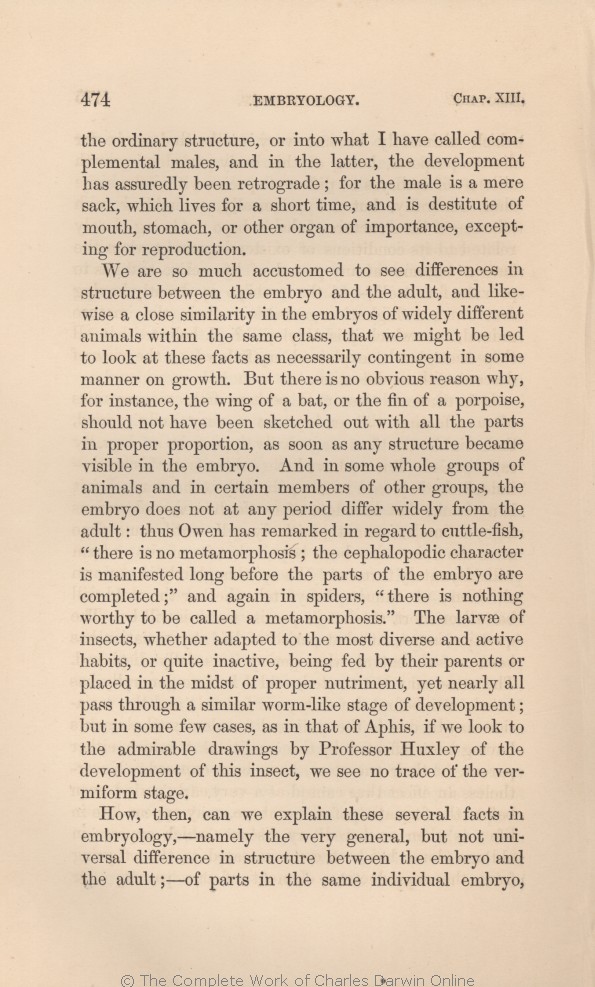the ordinary structure,
or | or 1859 1860 1861 1866 1869 | | and 1872 |
| males, 1861 1866 1869 | | males: 1859 1860 | | males; 1872 |
| latter, 1859 1860 1861 1866 1869 | | latter 1872 |
| retrograde; 1859 1860 1861 1866 1869 | | retrograde, 1872 |
| time, 1859 1860 1861 1866 1869 | | time 1872 |
| or 1859 1860 1861 1866 1869 | | and every 1872 |
| organ 1859 1860 1861 1866 1872 | | organs 1869 |
| for 1859 1860 1861 1866 | | those for 1869 1872 |
|
We are so much accustomed to see
differences | differences 1859 1860 1861 1866 | | a difference 1869 1872 |
| and like-wise a close similarity in the embryos of widely different animals within the same class, 1861 |
| and likewise a close similarity in the embryos of widely different animals within the same class, 1859 1860 |
| and like-wise a close similarity in the embryos of different animals within the same class, 1866 |
| OMIT 1869 1872 |
| might be led 1859 1860 1861 1866 |
| are tempted 1869 1872 |
| these facts as necessarily contingent in some manner 1859 1860 1861 |
| these facts as in some manner necessarily contingent 1866 |
| this difference as in some manner 1869 |
| this difference as in some necessary manner contingent 1872 |
| on 1859 1860 1861 1866 1872 |
| necessarily contingent on 1869 |
| obvious 1859 1860 1861 1866 | obvious 1869 1872 |
| wing 1859 1860 1861 1866 1872 | | wings 1869 |
| fin 1859 1860 1861 1866 1872 | | fins 1869 |
| the 1859 1860 1861 1866 | | their 1869 1872 |
| structure 1859 1860 1861 1866 1869 | | part 1872 |
| visible 1859 1860 1861 1866 | | visible. 1869 1872 |
| in 1859 1860 1861 1866 | in 1869 1872 |
| the 1859 1860 1861 1866 | the 1869 1872 |
| embryo. 1859 1860 1861 1866 | embryo. 1869 1872 |
| 2 blocks not present in 1859 1860 1861 1866 1869; present in 1872 | | In some whole groups of animals and in certain members of other groups this is the case, and the embryo does not at any period differ widely from the adult: thus Owen has remarked in regard to cuttlefish, "there is no metamorphosis; the cephalopodic character is manifested long before the parts of the embryo are completed."
Land-shells and fresh-water crustaceans are born having their proper forms, whilst the marine members of the same two great classes pass through considerable and often great changes during their development.
|
| And in 1859 1860 1861 1866 | | In 1869 |
| groups, 1859 1860 1861 1866 | | groups 1869 |
| the 1859 1860 1861 1866 |
| this is the case, and the 1869 |
| completed;" 1859 1860 1861 | | completed." 1866 1869 |
| and 1859 1860 1861 | and 1866 1869 |
| again 1859 1860 1861 | again 1866 1869 |
| in 1859 1860 1861 | in 1866 1869 |
| spiders, 1859 1860 1861 | spiders, 1866 1869 |
| "there 1859 1860 1861 | "there 1866 1869 |
| is 1859 1860 1861 | is 1866 1869 |
| nothing 1859 1860 1861 | nothing 1866 1869 |
| worthy 1859 1860 1861 | worthy 1866 1869 |
| to 1859 1860 1861 | to 1866 1869 |
| be 1859 1860 1861 | be 1866 1869 |
| called 1859 1860 1861 | called 1866 1869 |
| a 1859 1860 1861 | a 1866 1869 |
| metamorphosis." 1859 1860 1861 | metamorphosis." 1866 1869 |
| 1 blocks not present in 1859 1860 1861 1872; present in 1866 1869 | | Land-shells and fresh-water crustaceans are born with
their proper forms,
whilst the marine members of these
two great classes pass through considerable and often great developmental
changes.
|
| The larvæ of insects, whether 1859 1860 1861 |
| With almost all insects, the larvæ, whether 1866 |
| The larvæ of most insects pass through a worm-like stage, whether they are active and 1869 1872 |
| the most diverse and active 1859 1860 1861 |
| diversified and active 1866 |
| diversified 1869 1872 |
| quite 1859 1860 1861 | | remaining 1866 | | are 1869 1872 |
| inactive, 1859 1860 1861 1866 | | inactive 1869 1872 |
| being fed by their parents or placed in the midst of proper nutriment, 1859 1860 1861 |
| being placed in the midst of proper nutriment or fed by their parents, 1866 |
| from being placed in the midst of proper nutriment 1869 1872 |
| yet nearly all pass through a similar worm-like stage of development; 1859 1860 1861 1866 |
| or from being fed by their parents; 1869 1872 |
| by Professor Huxley of the development of this insect, 1859 1860 1861 1866 |
| of the development of this insect, by Professor Huxley, 1869 1872 |
| no 1859 1860 1861 | | hardly any 1866 1869 1872 |
|
How, then, can we explain these several facts in embryology,—
namely | namely 1859 1860 1861 | | namely, 1866 1869 1872 |
| but 1859 1860 1861 1866 | | though 1869 1872 |
| universal 1859 1860 1861 | | universal, 1866 1869 1872 |
| of 1859 1860 1861 1866 | | the various 1869 1872 |
| individual 1861 1866 1869 1872 | | indivividual 1859 1860 |
| embryo, 1859 1860 1861 1869 1872 | | embryo 1866 |
|









